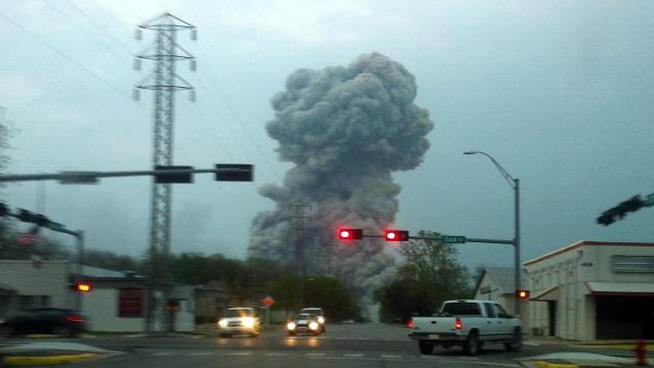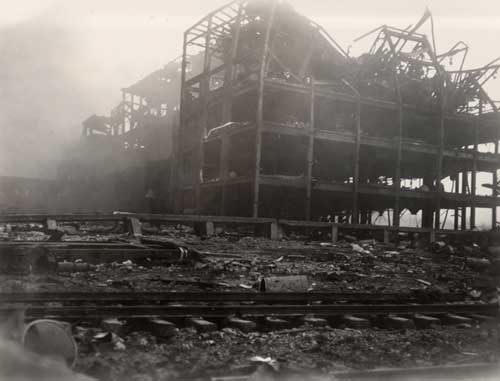by Ryan Hill
April 18, 2013
While the country continues to mourn the victims of the horrifying bombing of the Boston Marathon, another deadly explosion devastated a small town called West (just south of Dallas, Texas). On the evening of April 17, a large fertilizer plant caught fire and, just minutes later, exploded with terrifying force.

The scale of the explosion is unimaginable for all but those who were there. The blast registered as a 2.1 magnitude earthquake, shattering windows and knocking doors open for miles around. One woman who lived more than a mile away saw her horses thrown into the air. People as far away as Arlington claim to have heard the noise, figuring it to be thunder. Emergency workers and witnesses report as many as sixty homes that surrounded the plant have been completely leveled, including an entire apartment building that now resembles “just a skeleton.” Hundreds are injured, many of them critically. So far, officials are reporting five to fifteen have died, but it’s unclear exactly what the human toll is at this point–this from a population of only 2,800.
Warning, this video contains disturbing content.
The town of West itself may as well be included in the casualty count. With the largest employer out of business and so many people in the town with serious injuries and left without homes, it’s difficult to say what kind of future remains there.
Could this have been prevented? Perhaps. The underfunding of agencies that safeguard workplace safety, like OSHA, is severe—so much that it’s almost easy to wonder why there aren’t more tragedies like these. Labor journalist Mike Elk reminded us over Twitter last night of an article he wrote on the topic several years ago:
“There are only 2,218 inspectors at both the federal and state level who inspect workplace safety to cover 7.5 million workplaces employing more than 130 million workers. That’s one inspector for every 57,984 workers. At this rate, OSHA can inspect a workplace on average once every 129 years and state OSHA inspectors could inspect one every 67 years. [emphasis added]”
By now, it’s likely that austerity budgets and the sequester have created an even more dire situation for regulatory agencies that safeguard workplaces. On top of that, the steady erosion of union membership leaves more and more workers without any real processes to have a voice on workplace conditions.
Was West Fertilizer Co. left on some kind of “honor system,” then? According to EPA reports pulled by the Dallas Morning News, the company checked “no” under fire and explosive risks and speculated that “the worst possible [accident] scenario…would be a 10-minute release of ammonia gas that would kill or injure no one.” We can only take the bosses at their word at our own risk…
By some accident of history, the West explosion came just one day after the 66th anniversary of the largest industrial accident in US history, the Texas City Disaster that claimed at least 581 lives on April 16, 1947. Perhaps less “accidental” or random, this disaster also happened in Texas and was also caused by a fertilizer explosion.

The Texas City Disaster, April 16, 1947
Workers Memorial Day, an annual day to remember workers who have been injured or killed on the job, is coming up on April 28. Here in Texas, the disaster in West will put the issue on the public radar (if not the Memorial Day), but sadly, it’s far from the only example of a dangerous workplace. Our most dangerous workplaces in the state are to be found wherever there is a construction site. According to a recent report put together by the Workers Defense Project / Proyecto Defensa Laboral,
“Between 2007 and 2011, 585 Texas construction workers died from workplace injuries, compared with 299 in California, which had a larger construction work force. And between 2003 and 2010, construction accounted for about 6% of the Texas work force, but 26% of workplace fatalities.”
Most of these workers are immigrants and many of them are undocumented and fearful of raising their voice about dangerous conditions. The subcontractors they work for have a number of ways to avoid comprehensive safety measures in the interest of cutting costs and they’ve got an ally in Gov. Rick Perry, who claims that “it’s not because of lack of regulation.” Is there anyone in Texas who doesn’t think that a little regulation and oversight might have helped the people of West last night?
West will be in the thoughts and prayers of millions over the coming weeks. As the saying goes, though, we should not only mourn, but also organize. We need to build movements to demand workplace safety, adequate funding for regulatory agencies that protect workers and our communities, and protection of the right for workers to organize—only these things, not the “bosses’ honor system,” can make sure we come home safe every day.
Ryan is a member of the Solidarity Web Editorial Committee and works with labor organizations in Dallas, Texas.

Comments
4 responses to “On the Tragic Plant Explosion in West, Texas”
I work in the construction trade the out fit I worked for had a safety director who was fond of that same statement of course his type is rare these days most times they just make you sign some stupid”tool box talk”before you get your check and by that they cover their ass then turn around and force you into unsafe tasks with worn out tools all to pad the bottom line with no union reps or osha support you do it or its down the road for you
I work in workplace safety and health, and this is the best article I’ve seen on this event so far. Kudos. It also came to my attention as I was wrapping up editing my org’s Workers Memorial Day Report, so the timing was uncanny. You will eventually be able to check it out post-April 28 at http://www.worksafe.org.
One quibble: these aren’t “accidents,” like lightning strikes and getting hit by a pan someone’s cat knocked out a window. I feel like that word should just be retired. If it can be reasonably anticipated and prevented, and it wasn’t, it’s not an accident.
I’m trying not to compare the tragedies in Boston and West out of respect for the many people affected by both, but I can’t help but think about how different the “response” will be to both. In Boston, we already see a relentless search to bring the perpatrator(s) to “justice” (well, the highly flawed notion of “justice” that happens in the context of imperialism, white supremacy, and Islamophobia, anyways–involving racial profiling, damn near martial law on the streets, and calls for violence against Muslims).
In West, will we see a relentless search for any form of justice? In this case, we aren’t exactly grasping at straws to figure out who might be complicit in the explosion. We know about past failures to obtain permits and other shady moves by management. We know what kind of measures prevent these tragedies, and it is far less costly than the trillions of dollars poured into occupations, the security state, and the prison system which are supposedly necessary to prevent more terrorist attacks.
No, we will probably be told just to move along. So many people in the state have already started work this morning in conditions that might prevent them from coming home. This is why we desperately need an organized response to disasters of this kind–there’s no “natural” reaction from this system to enact preventative measures or to “learn lessons” and never has been! Just as the response in Boston will follow a markedly racist and imperialist path, the response in West will be to let bosses off the hook (or, at best, focus only on this one workplace).
We’ve got to demand that things be done differently. Fortunately, some organizations, like the Workers Defense Project (their report is mentioned in the article above) are already working on the issue and organize a yearly “Day of the Fallen Worker” to memorialize construction worker deaths in Austin, TX. We need to support and broaden this type of work wherever possible…
Here’s a video from the last “Day of the Fallen” event in February, 2013: